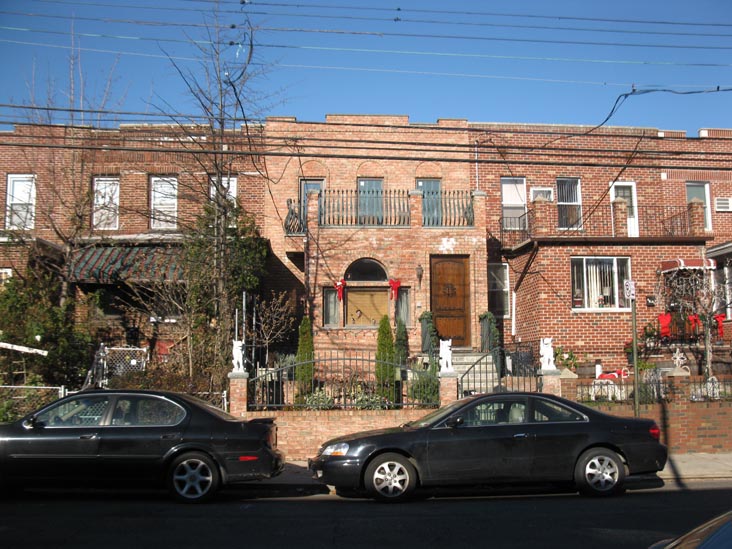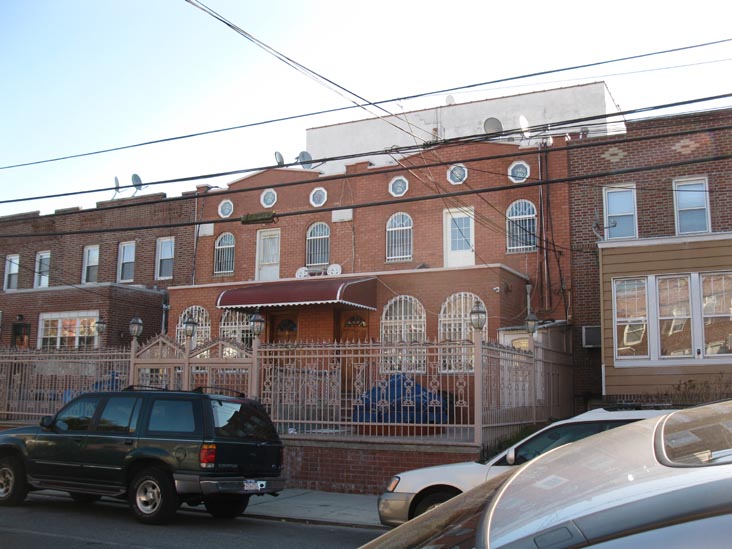What If Jeffrey Maier Saw That Fly Ball Coming Out Toward The Right Field Bleachers And Instead Pulled Back, Allowing Tony Tarasco To Make The Catch?
Except for the fact that there are a lot of kinds of houses in Astoria, there only seem to be two types of houses in Astoria. One type has two floors and a basement:

The other type has three floors and a basement:

And then there are some that started out as two floors and a basement and were expanded to include a third floor and maybe even the house next door:

An aside: Every house apparently was built in 1930. If you look at a listing, nine times out of ten they list the year built as 1930. It's as if the entire borough was created in 1930. Cathy, the buyer's representative, told us that there were only a few eras of development in Queens: Nothing was built during the Depression, for obvious reasons, and nothing was built during World War II, for similarly obvious reasons. So I guess that leaves 1930. When in doubt, just say 1930. Now it's possible that there was a lot of construction that took place in 1930. The Astoria Line — i.e., the present-day N/Q train — was opened in 1917, so in some ways it makes sense that major construction would follow, but every single house? I just spent a long detour searching for clues in the nytimes.com archives. First, you have to remember that all of the streets were named something else back then. Here's an example, a Queens map from 1910. The streets were mapped in 1910; we lived on Lathrop Street between Winthrop and Wolcott Avenues. That elevated line ran along Second Avenue, then Debevoise Street. The Beer Garden would have been located west of Debevoise Street on Woolsey Avenue. From there I plugged in the names of the streets and quit looking after awhile because it was taking too long. I think the names of the streets in Queens changed in the very early 1930s, though I'd have to check on that, too.
Back in June, when we were first starting to look at houses, Jen and I saw a three-story house in Astoria that was advertised as a handyman's special. The price was a little outside of the ballpark, or so we thought at the time, but we figured it wouldn't hurt to look, thinking maybe we could perhaps negotiate our way to Jeffrey Maier range, especially if it needed a little work.
The house we looked at was a real fixer upper. Even a piece of shit. It was one of those situations, if memory serves, where one family lived in it for years and never seemed to do anything by way of repairs. The fixtures were ancient. The drop ceiling in the kitchen had fully disengaged a few presidential administrations ago. There was odd Greek graffiti near the staircase on the first floor. The electricity didn't ever seem to be updated. We could go on and on. The sense we got at the time was that fixing up this place would be way above our pay grade. The listing agent guessed that the house needed more than $100,000 worth of work.
By December we decided we wanted to take a second look at the place.
One, it had a perfect setup: The secondary unit was on the third floor — not the basement — and it had a great open layout with lots of light. The primary unit was two floors, which was a lot bigger than anything Jen and I had lived in before.
The idea of the house was perfect for us, and after seeing so many other places, I kept returning to this particular house. We just had to figure out how big a piece of shit it was. I was guessing — hoping against hope, I suppose — that maybe most of the faults with the place were more cosmetic than, say, structural.
As it turned out, the house was still on the market. We contacted the listing agent and asked if we could see it with Michael.
Bad News: The listing agent told us that the house was in contract. Maybe Good News: The listing agent had another house just like it available, only two doors down. It was in much better shape — move-in condition! — though it was listed for $90,000 more, placing it somewhere near the right field upper deck.
We all saw the place on a Thursday evening. It looked like the house two doors down but in a lot better shape — just like the listing agent said. It looked really promising. The only thing was that we couldn't see the top floor apartment — there was a tenant living there — but if we were serious about it, the agent would get in touch with her and get her permission to enter the apartment.
We got back to the agent and told him that we'd like to see the top apartment, too. We scheduled a return visit for noon that Saturday. By 1:30 p.m. we were sitting down at lunch strategizing our starting negotiating point.
After all the places we had seen this house seemed different. For one, it was a place, maybe the first place, we all actually agreed would work. There weren't any lingering questions about physical safety or structural integrity. It was in a neighborhood we all agreed was a "smart investment." There weren't any bizarre quirks like main bathrooms in basements or apartments in basements or anything about the basement other than just a basement. In this case, it featured a relatively nice finished basement. It wasn't like when you applied for a job that you weren't sure you wanted to take or went on a date with someone whom you felt like there was no chemistry with. There was no apparent reason this place wouldn't work. In short, it felt right.
When we travel, I'm the one who has no idea how to haggle. She always tries to get me to play "bad cop" and I always fail her. She'll say something along the lines of, "Oh, this is a nice scarf," and instead of me saying "You don't really need another scarf," I'll say something along the lines of, "Just get it." Because my sense is always that haggling over a few pesos, baht, rupees or dinars is a waste of time. So early on, Jen was determined to keep me far, far away from the negotiating process.
When it came to negotiating a price, I was hesitant to return to the 20 percent game, thinking it absurd. Instead we tried a figure closer to 14 percent. This time Jen called the agent and asked him what he thought about that figure. He counseled us to start out closer to 8.5 percent. Jen asked us what we thought.
Michael had been plugging in numbers and figured that when costs are spread out over thirty years, we could afford to move the fences of our ballpark out some. We decided to follow the agent's advice.
A few minutes later, the agent called us back. We were standing under the elevated train near the Grand Central Parkway. He said that the sellers were countering with 5.5 percent.
"Fuck, dude!" Michael said. Or he said something like that. Maybe I'm penciling in what I was thinking. Suffice it to say, we were happy with this price. After seeing so many places, and seeing enough purchase prices, we were comfortable with the price, and it seemed like a price that indicated that the sellers were serious about selling the house.
Michael thought we should negotiate further. Ten thousand more. Jen and I were hesitant.
"What would it hurt?"
So Jen called the agent back. The sellers countered with five thousand less. We accepted it.
"Fuck, dude, this is totally happening!" Michael said. Or he said something like that. I'm probably penciling in what I was thinking again.
So in December we finally ended our search. We had a house and we would soon be in contract. The agent was going to fax us a binder.
That was the easy part.
Posted: December 13th, 2011 | Author: Scott | Filed under: The Cult Of Domesticity | Tags: Kawama, Overused Baseball Metaphors, Queens Street Names, You Interfere With One Lousy Fly Ball And Suddenly You're A Metaphor For Years To Come


Leave a Reply
You must be logged in to post a comment.